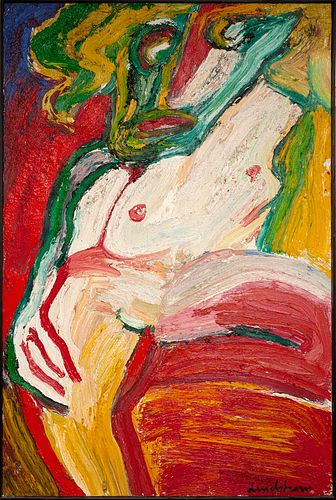BENGT LINDSTRÖM (Sweden, 1925-2008). Nº2 Pasan Modele, 1984. Oil on canvas. Signed in the lower right corner.
Lot 106
About Seller
Setdart Auction House
Carrer Aragó 346
Barcelona
Spain
Setdart Subastas was born in 2004 and is currently the first online art auction in Spain with solidity, prestige and reliability guaranteed by our more than 60,000 users. Setdart has a young, dynamic and enterprising team ready to successfully manage the purchase and sale of art works through custom...Read more
Categories
Estimate:
EUR€22,000 - EUR€24,000
$23,655.91 - $25,806.45
Absentee vs Live bid
Two ways to bid:
- Leave a max absentee bid and the platform will bid on your behalf up to your maximum bid during the live auction.
- Bid live during the auction and your bids will be submitted real-time to the auctioneer.
Bid Increments
| Price | Bid Increment |
|---|---|
| EUR€0 | EUR€10 |
| EUR€200 | EUR€25 |
| EUR€500 | EUR€50 |
| EUR€1,000 | EUR€100 |
| EUR€3,000 | EUR€200 |
| EUR€5,000 | EUR€500 |
| EUR€10,000 | EUR€1,000 |
| EUR€20,000 | EUR€2,000 |
| EUR€50,000 | EUR€5,000 |
About Auction
By Setdart Auction House
Nov 16, 2021
Set Reminder
2021-11-16 08:00:00
2021-11-16 08:00:00
America/New_York
Bidsquare
Bidsquare : Contemporary and Actual Art
https://www.bidsquare.com/auctions/setdart-auction-house/contemporary-and-actual-art-7839
Setdart Auction House sofia@setdart.com
Setdart Auction House sofia@setdart.com
- Lot Description
BENGT LINDSTRÖM (Sweden, 1925-2008). Nº2 Pasan Modele, 1984. Oil on canvas. Signed in the lower right corner. Titled and dated on the back. Size: 200 x 130 cm; 203 x 133 cm (frame). Lindström was one of Sweden's best known contemporary artists with a characteristic and personal style in which he fused a multitude of colors, in which he often included figurative elements, sometimes distorted. He began his development in artistic Stockholm, and later moved on to Copenhagen, Chicago and Paris. His experiences helped him develop his own style. A unique style that would make him recognized worldwide. Stylistically Bengt's early years as an artist reveal a strong influence from local Norrland artists. Although he once moved to Paris after his short stay at the College of Arts, Crafts & Design, Bengt studied with Isaac Grünewald in Stockholm for a year. Grünewald was one of the pioneers of Swedish modernism and had studied with influential artists such as Matisse. Bengt found inspiration in this new aesthetic and began to develop his style from these premises. He abandoned Norrland landscape motifs and attempted to develop a modern style. During this period, he was strongly inspired by Picasso, Matisse and other leading artists in the avant-garde movement. When World War II ended, Bengt studied in Copenhagen at the Academy of Art under Aksel Jørgensen during 1945-1946. There he first experienced contemporary art through the basic expressions and myths of what later became the COBRA movement. Subsequently, he crossed the Atlantic to Chicago, where the Art Institute of Chicago provided new insights through the abstract expressionism of Pollock and De Kooning. But it was Paris that attracted him, as Paris once again became the international center of arts and culture. After spending a year in Chicago, the dream of France became a reality. In the summer of 1947, Bengt arrived in Paris with nothing but a few dollars he had won in late night card games with other artists and shady characters from the Chicago underworld. The first few years in Paris were difficult although Bengt was extremely productive but sold almost nothing. During this time, under the guidance of his teachers André Lhote and Fernand Léger, Bengt experimented with a wide variety of techniques. By the mid-1950s, collage was the dominant technique, he also tried working in mosaics for a year, only to switch completely to silkscreen the next year. During this stage he was forced to paint in black and white during this period because he could not afford to buy colors. If he unexpectedly got hold of some colors, he would mix them with leftover powder paint to stretch them. The turning point came in the late 1950s, when a British art dealer who traveled to Paris in search of "unusual" artists bought several of his paintings. With the money from this first sale, Bengt Lindström was finally able to paint the way he wanted to. The first thing he did was to buy suitable paints and canvases. Making pieces with thick layers of yellow, red, green and blue replaced the black and white; and because of his increasingly strong brushstrokes, the paintings took on a new dimension. The abstract and expressionistic quality of his images became more obvious. The landscape paintings gradually disappeared, replaced by the distorted mask-like faces and, later, the Nordic mythology that has characterized his art ever since. Abandoning correct anatomy and representation and concentrating instead on colors and texture, Bengt thus found his way to articulate the primitive and violent qualities he had been searching for in the mountains and forests of northern Sweden. Because of their frenetic combination of composition and color, Bengt Lindström's paintings emerged on a border between internal complexity and external simplicity. During the 1960s, he carved out a position as one of Sweden's greatest contemporary artists, with exhibitions in cities such as Paris, London, Brussels, Cincinnati and Tokyo. Bengt became particularly highly regarded in southern Europe. In Italy he was given the nickname "Vento del Nord" (North Wind) because of his vivid colors and strong brushstrokes. Many people associated his style with Sami culture. Bengt was an extremely productive artist and held several exhibitions per year in various locations around the world.
- Shipping Info
-
In-house shipping available. Please inquire at admin@setdart.com.
-
- Buyer's Premium



 EUR
EUR CAD
CAD AUD
AUD GBP
GBP MXN
MXN HKD
HKD CNY
CNY MYR
MYR SEK
SEK SGD
SGD CHF
CHF THB
THB
















